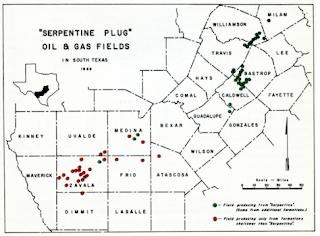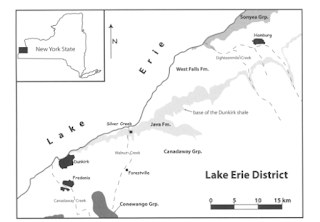The 1915 headlines read, ‘Oil in an Igneous Rock,” which certainly piqued the curiosity of oil finders, used to displaying their porous sandstone and limestone cores, stained with oil, in their office display cases.
But, in South Texas, they had done it. They had found oil in a green igneous rock they dubbed “serpentine,” even though it was actually an altered tuff resulting from underwater volcanic eruptions.
Udden, J. A., and Bybee, H. P., and others, 1916
The adventure had started a year earlier. In 1914, Fritz Fuchs, a rancher deep in south Texas near the small town of Thrall, decided to drill a water well for his cattle. He did not encounter water, but at about 300 feet, he brought up a strange mix of oil, salt water, and what appeared to be weathered igneous rock, green in color. Mystified, he called the University of Texas geology department to see if they could shed light. The result was a well drilled in February 1915, which was the discovery well for the Thrall field, and the first of many so-called “serpentine plugs.”
At least one study has pointed out that the deposition of the tuffaceous mounds occurred in conjunction with submarine volcanic vents which emitted volcanic ash which then was deposited in the form of mounds, which subsequently altered to palagonite. The volcanic activity occurred with the deposition of chalk and marl of the upper Austin and lower Taylor Groups, which served as both source and seal.
Interaction between the submarine volcanic system and carbonates
It turns out that all along a belt of volcanic activity, there were similar submarine volcanic eruptions and they became perfect reservoirs for oil generated in the adjacent source rocks. The stratigraphic traps were found in the porous zones of tuff, and also in porous zones in the surrounding carbonates, and in traps in sands draping over the serpentine plug, and in fracture porosity in the carbonates near the plugs (Loucks, 2022).
The wells could be incredibly prolific, with a feature covering less than 10 acres producing 100,000 barrels. Others were not as prolific. However, by 1986, more than 47 million barrels had been produced (Matthews, 1986).
The serpentine plugs are found associated with the volcanic centers that align with the pre-Tertiary Balcones and Luling regional fault and fracture systems. Some of the minerals in the tuffaceous mounds are magnetic, resulting in magnetic anomalies.
Some of the minerals in the tuffaceous mounds are magnetic, resulting in magnetic anomalies. While the first oil-rich serpentine plug was discovered by accident, science was used to discover dozens of the features scattered along the belt of pre-Tertiary-age submarine volcanic activity. The fact that the features tended to be shallow and of dramatically different lithology than the surrounding carbonates, and that were often oil seeps, made it possible to use new methods, which included surface geochemistry, in which soil samples were taken, and plants observed to see if they were affected by hydrocarbons in the soil. Second, newly developed magnetometers were used. Most were truck-mounted, and they were able to detect anomalies by means of differences in the magnetic field.
Source: Loucks, 2022
The features were small, and it took a lot of patience to find them, but when they did, the wells could be extremely prolific. Ranging from just a few feet deep, to 5,000 feet deep, the wells were inexpensive to drill.
Today, with high-resolution drone-mounted magnetometers, and highly accurate surface geochemistry, it’s possible to revisit a fascinating play, which to this day is one of the few areas of the world where oil is found in igneous rocks.
I love this play, and I’m thrilled to have an original copy of the November 25, 1916 Bulletin of the University of Texas published by the Bureau of Economic Geology and Technology which is dedicated to the Thrall Oil Field.
References
Loucks, R. G., R. R. Reed (15 April 2022) Implications for carbonate mass-wasting complexes induced by volcanism from Upper Cretaceous Austin Chalk strata in the Maverick Basin and San Marcos Arch areas of south-central Texas, USA. Sedimentary Geology. Vol 432.
Matthews, T. F. (1986) The Petroleum Potential of "Serpentine Plugs" and Associated Rocks, Central and South Texas. Baylor Geological Studies Bulletin, Spring 1986.
Udden, J. A., and Bybee, H. P., and others, 1916, The Thrall Oil Field, by J. A. Udden and H. P. Bybee [and] Ozokerite from the Thrall Oil Field, by E. P. Schoch [and] The Chemical Composition of the Petroleums Obtained at Thrall, Texas, by E. P. Schoch and W. T. Read: University of Texas, Austin, Bureau of Economic Geology and Technology, Bulletin 66, 93 p.


.png)
